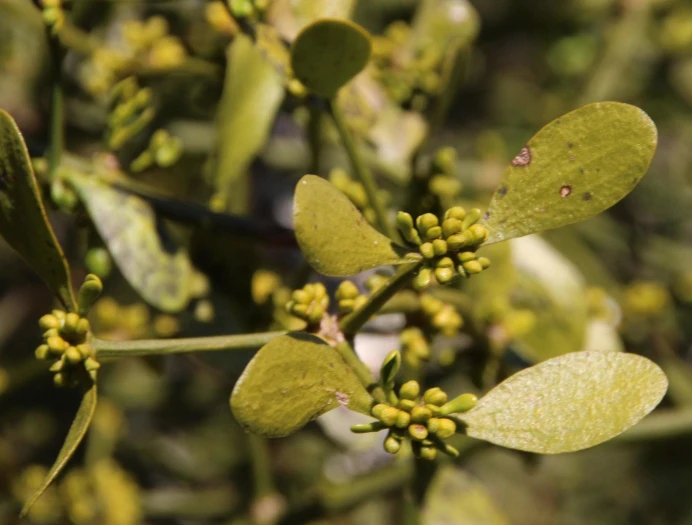Dusky Mistletoe
(Viscum obscurum)
Dusky Mistletoe (Viscum obscurum)
/
/

© Tony Rebelo
CC BY-SA 4.0
Image By:
© Tony Rebelo
Recorded By:
Copyright:
CC BY-SA 4.0
Copyright Notice:
Photo by: © Tony Rebelo | License Type: CC BY-SA 4.0 | License URL: http://creativecommons.org/licenses/by-sa/4.0/ | Uploader: tonyrebelo | Publisher: iNaturalist |
























Estimated Native Range
Climate Requirements for La Mesa, California
| This Plant | Your Site | Plant Suitability for Your Location | ||
|---|---|---|---|---|
| • Precipitation | 24" - 37" | 13" | Your precipitation may be insufficient for this plant. Irrigate N" / year. | Irrigate N" / year |
| • High Temp. | 76°F - 84°F | 86°F | Your summer temperatures are normal for this plant. | Excellent |
| • Low Temp. | 39°F - 51°F | 45°F | Your winter temperatures are normal for this plant | Excellent |
This plant should grow well at your location with about N inches per year (Y minutes per month) of irrigation.
Summary
Viscum obscurum, commonly known as Dusky Mistletoe or Obscure Mistletoe, is a semi-parasitic evergreen shrub native to South Africa. It typically grows slowly to a height and width of 1-2 feet (0.3-0.6 meters). This mistletoe has a distinctive growth form, with branching stems that often create a dense, tangled clump. Its small, yellow-green flowers are inconspicuous and bloom in the spring, followed by white to pinkish berries that are attractive to birds. The plant is not particularly showy but plays a crucial ecological role as a food source for wildlife.
Dusky Mistletoe is not commonly cultivated due to its parasitic nature, but when it is, it’s used for its ecological benefits, particularly in wildlife gardens where its berries provide food for birds. It requires a host plant, typically a tree or shrub, from which it derives water and nutrients. In cultivation, it prefers full sun to part shade and can adapt to a range of soil types, including clay, loam, or sandy soils, with medium to fast drainage. It is drought-tolerant, requiring low amounts of water once established. There are no popular garden cultivars of Viscum obscurum due to its specialized growth requirements and niche appeal. Potential problems include the ethical considerations of cultivating a parasitic plant that may harm its host.CC BY-SA 4.0
Dusky Mistletoe is not commonly cultivated due to its parasitic nature, but when it is, it’s used for its ecological benefits, particularly in wildlife gardens where its berries provide food for birds. It requires a host plant, typically a tree or shrub, from which it derives water and nutrients. In cultivation, it prefers full sun to part shade and can adapt to a range of soil types, including clay, loam, or sandy soils, with medium to fast drainage. It is drought-tolerant, requiring low amounts of water once established. There are no popular garden cultivars of Viscum obscurum due to its specialized growth requirements and niche appeal. Potential problems include the ethical considerations of cultivating a parasitic plant that may harm its host.CC BY-SA 4.0
Plant Description
- Plant Type:
- Height: 1-2 feet
- Width: 1-2 feet
- Growth Rate: Slow
- Flower Color: Yellow
- Flowering Season: Spring
- Leaf Retention: Evergreen
Growth Requirements
- Sun: Full Sun, Part Shade
- Water: Low
- Drainage: Fast, Medium
Common Uses
Bird Garden, Low Maintenance
Natural Habitat
Open woodlands and forest edges across South Africa
Other Names
Common Names: Obscure Mistletoe
Scientific Names: Viscum obscurum , Aspidixia bivalvis , Viscum bivalve , Viscum brevifolium , Viscum obscurum var. brevifolium , Viscum obscurum var. longiflorum , Viscum obscurum var. longifolium , Viscum oliganthum , Viscum pauciflorum , Viscum rotundifolium
GBIF Accepted Name: Viscum obscurum